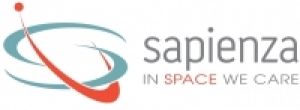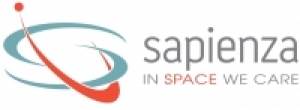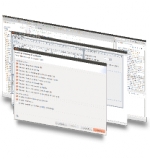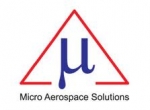Displaying items by tag: software
Sapienza Consulting Awarded Three-Year Contract by RAL Space
Sapienza Consulting today announces it has been awarded a three-year contract to supply the ECLIPSE software suite and professional services to RAL Space, which is an integral part of the Science and Technology Facilities Council's (STFC) Rutherford Appleton Laboratory (RAL).
RAL Space joins the growing list of successful European SMEs that benefit from adopting modules of the ECLIPSE suite in their space projects management processes.
In particular, RAL Space will take advantage of the Document Configuration & Change Management (DCCM), the Non-Conformance Tracking System (eNCTS) and Action Items Manager (AIM) modules.
Mike Bearman, Managing Director at Sapienza Consulting said: “We are proud to welcome on board RAL Space. Not only is RAL Space our first UK based client but their procurement of the ECLIPSE suite follows an increasing adoption of our ECSS-compliant toolset. We see this as a great step forward for Sapienza into a growing UK space sector, and an opportunity to open further doors to the UK (aero)-space and defence sector through the expected industry usage of the magnificent RAL facilities.”
ECLIPSE is the only collaborative suite of integrated applications designed with the invaluable experience of space industry professionals for use by European space sector organisations ranging from Small and Medium Enterprises (SMEs) all the way to International Agencies.
The ECLIPSE software suite helps space project and mission teams achieve higher efficiency, better control and compliance to ECSS (European Collaboration for Space Standardization) in key project and business areas such as:
- Project Management (PM)
- Product Assurance (PA)
- Configuration Management (CM)
- Quality Assurance (QA).
The DCCM module fulfils all the document configuration requirements of a space project. Each integrated function is tailored specifically for the space industry’s needs and best practices. Furthermore, it supports the document’s entire evolution (i.e. creation, modification, evolution and distribution) throughout the document lifecycle.
eNCTS is the only commercially available ECSS-compliant software that enables recording, monitoring and closure of Non-Conformances (NCs) found during the design, manufacture, assembly, integration and testing phases of space system engineering projects. The Non-Conformance Tracking System (eNCTS) tool removes the need of managing NCs (and all associated information) via time-consuming, error-prone, paper-oriented processes. eNCTS provides Quality and space Product Assurance functions with improved visibility into the status of NCs, as well as a structured approach to collecting and managing critical data associated with the NC resolution and product realisation process.
AIM allows the creation, allocation, monitoring and tracking of Action Items (AIs) and their associated information across small and large project teams alike. Each Action Item can be allocated to an Actionee and multiple Contributors, who can access and contribute to the Action Item’s progress, completion and closure via the web, in accordance with security permissions. Each AI enables all those involved to collaborate via a thread-based discussion capability, which permits additional information to be provided in the form of video, images or document attachments.
About Sapienza Consulting Group
The Sapienza Consulting Group is a leading provider of space mission and project support through people, software and services. Since 1994, Sapienza has been a supplier to the European Space Agency, as well as the other key players of the European institutional and commercial space sector. The Group now consists of strategically located offices in Germany, The Netherlands, Italy, The United Kingdom, Belgium and France.
For Media information contact:
Sapienza Consulting Group
Space Business Park
Kapteynstraat 1
2201 BB
Noordwijk
The Netherlands
Ph: +31(0)71 407 6518
Fx: +31(0)71 407 6536
Sapienza’s ECLIPSE Suite becomes a supplier on the UK Government’s Digital Marketplace for G Cloud 9
Sapienza Consulting (LTD) has announced today that the company has become a supplier of the UK Government Digital Service through the G-Cloud 9 framework. As of 22nd May 2017, Sapienza will be able to supply its ECLIPSE SaaS to the government and wider public sector buyers through the UK Digital Marketplace.
On the Digital Marketplace, Sapienza will be selling modules of its ECLIPSE suite (DCCM, eRISK, eNCTS, DAB, DASH) as Cloud Software services.
This is a great opportunity for Sapienza as it widens our current growth outside the space sector with our leading Project Management suite (ECLIPSE). Through the ECLIPSE software suite, Sapienza believes it can help government officials to achieve higher efficiency and better control in the delivery of their digital projects and services by standardizing its Project Management, Product Assurance, Configuration Management, Quality Assurance, and Business Reporting approaches.
About Sapienza Consulting (Holding BV) Group
The Sapienza Consulting Group is a leading provider of Space & Defence mission and project support through people, software and services. Since 1994, Sapienza has been a supplier to the European Space Agency, as well as the other key players of the European institutional and commercial space sector. The Group now consists of strategically located offices and subsidiaries in Germany, The Netherlands, Italy, The United Kingdom, Belgium and France.
For Media information contact:
Space Business Park
Kapteynstraat 1
2201 BB
Noordwijk
The Netherlands
Ph: +31(0)71 407 6518
Fx: +31(0)71 407 6536
About Digital Marketplace
The Digital Marketplace is part of the UK Government Digital Service. Public sector organisations can use the Digital Marketplace to find people and technology for digital projects. The Government Digital Service employs more than 500 staff throughout the UK.
For Media information contact:
Tecnau Transport Division Srl
Tecnau Transport Division s.r.l company operates in the sector of Supervision/Scada systems and Remote Control. The company develops software products and provides qualified support with special attention to technical innovation for the engineering of complex rail transport systems.
The company is certified with quality management system compliant with Norm ISO 9001:2008 for the activities of design, installation and support of software and information systems for systems (plants) of management of railways traffic.
Generation 1 Onboard Software
Bright Ascension’s Generation 1 Onboard Software product, or Gen1 for short, combines our mature component-based software framework with proven software components and an Eclipse-based tool system.
It provides an excellent solution for the command and data handling needs of the next generation of highly-capable CubeSats and other nano-satellites. Gen1 will enable you to rapidly and cheaply produce robust software for your spacecraft whatever subsystems you choose, and, where we already provide support for your subsystems, get a near-complete solution out-of-the-box. Bright Ascension are also able to offer bespoke solutions based on this software, letting you focus on the aspects of the mission that are most important to you.
Key Benefits
Rapidity
Rather than writing software from scratch, Generation 1 provides you with most of the functionality you need off-the-shelf. This allows you to focus on producing or procuring code to cover the unique parts of your mission. Whatever development you do, cross-platform support means most development and testing can be done on desktop PCs without access to flight hardware or engineering models. On the ground side, we include a graphical test application software which will provide telemetry monitoring and telecommand to support your development and AIT activities.
Flexibility
The component-based architecture we’ve used for Generation 1 means that software can be assembled from a library of existing, validated code and supplemented with new components to introduce new capabilities.
This flexibility extends into orbit, with a high level of reconfigurability and automation to cope with evolving mission needs and provide plenty of troubleshooting options.
Portability
Generation 1 was designed with portability in mind. An abstraction and layer and flexible build system make it straightforward to add support for new operating systems and architectures. It is also easy to develop your onboard software on one platform, such as desktop PC, and transfer your working solution to another platform, such as an onboard computer, with few, if any, changes.
Interoperability
Wherever possible we adopt recognised and mature international standards to promote interoperability and portability. Generation 1 uses CCSDS standards for communications and for I/O handling on board giving you the most options for the operation of your spacecraft and adaptation of existing software to the Generation 1 framework. Gen 1 includes an ECSS Packet Utilisation Standard (PUS) compliant protocol stack, providing a standard TM/TC solution already compatible with many existing ground segments.
Robustness
Our heavily tested, proven code is developed to MISRA-C standards for safe, reliable embedded systems. Our scheduling system facilitates the development of robust, verifiable task schedules allowing you to be sure your onboard software will meet strict real-time requirements.
Ease of Use
We recognise the importance of good documentation which is why you will find comprehensive API reference documentation, a full user manual and thoroughly documented source code.
Bright Ascension Ltd
We started Bright Ascension in 2011 to offer a fresh and innovative approach to engineering research and development in the space industry and other high technology areas. We have a unique mix of down-to-earth, hard-nosed, practical engineering experience and a rigorous approach sharpened through academic research. Our varied back-catalogue means that we are as comfortable with abstract theoretical concepts as we are with getting our hands dirty and producing effective products in difficult conditions. Knowing the theory allows us to take a step back and offer a clear perspective on your problems; being practical means that we never lose sight of the real-world constraints you are working with.
We have applied our experience and innovation to Generation 1, our industry-leading onboard software product for Nano-Satellites, including CubeSats. Rather than being a one-size-fits-all solution, or requiring significant accompanying consultancy, Generation 1 is a software toolkit, allowing you to quickly and easily assemble onboard software to meet the needs of your mission from a library of proven software components, utilising our mature software framework and development tools. We can provide an end-to-end solution with the addition of our Generation 1 Mission Control System, which complements our onboard software to provide a complete solution from early prototyping, through early integration, AIT and on-orbit operations.
Micro Aerospace Solutions, Inc.
Micro Aerospace Solutions is an American company specialized in space software systems.
At Micro Aerospace Solutions we specialize in thruster design, propulsion systems, attitude control, command and data handling, and computer and communications systems for small spacecraft and nanosatellites. We also offer spacecraft and system testing, data collection, and research for new projects or ideas. We have experience with electrical system circuit board design, layouts for microcontroller systems, environmental control, navigation and tracking, imaging systems, scientific sensors, and display systems. Our background in aerospace systems allows us to understand low-power and high-efficiency designs with tight tolerance requirements.
Software: Astrophysics Source Code Library
The Astrophysics Source Code Library (ASCL) is a free on-line registry for source codes of interest to astronomers and astrophysicists, and lists codes which have been used in research that has appeared in, or been submitted to, peer-reviewed publications. ASCL entries are indexed by the SAO/NASA Astrophysics Data System (ADS).
It has been founded in 1999 by Robert Nemiroff and John Wallin, takes an active approach to sharing astrophysical source code. ASCL's editor seeks out both new and old peer-reviewed papers that describe methods or experiments that involve the development or use of source code, and adds entries for the found codes to the library. This approach ensures that source codes are added without requiring authors to actively submit them, resulting in a comprehensive listing that covers a significant number of the astrophysics source codes used in peer-reviewed studies.
[ Copernical note: this product has also a project page on Copenical : ASCL ]
Machinalis
Machinalis is a company dedicated to Research and Software development, being Python, Django and Agiles methodologies as the founding tools for our projects.
Our primary purpose is to change the role of Argentina in the worldwide IT Industry, transforming ourselves suppliers of High Added Value Solutions and Computer Science.
From within Machinalis and our experienced teams, we implement unique solutions through powerful and innovative tools and high standards of human resource, supported by standardized procedures of development, testing, implementation, monitoring and updates.
In Machinalis we are committed to making the client’s reach, objectives and expectations our primary goal. For this, our philosophy lies on inviting our clients to become active members in every step of the project, promoting long-term relationships.
We are the power button that moves your idea's wheels; we are... the missing piece.
Over the next 2 years, our goal is to become the Number 1 company in the provision of Python development from Latin America to the United States and Europe.
www.machinalis.com
NAPEOS software
NAPEOS, the NAvigation Package for Earth Observation Satellites, is a state of the art software system for GNSS data processing providing results with a very accuracy.
NAPEOS is developed and maintained by the European Space Operations Centre (ESOC) of the European Space Agency (ESA). The NAPEOS developments started around 1995. In 2003 the GNSS capabilties started to be added a project that was finished in 2007. After significant testing the navigation support office at ESOC (OPS-GN) started to use the NAPEOS software in January 2008 for all its IGS activities.
A significant number of companies and individuals have been involved in the development of the NAPEOS software. Of course the major part of the GNSS work has been done at the navigation support office (OPS-GN) at ESOC with a special mentioning for the company GMV. GMV has been responsible for major parts of the actual programming of the NAPEOS source code.
At OPS-GN, in ESOC, NAPEOS supports all the activities in the International GNSS Service (IGS), the International DORIS Service (IDS), the International Laser Ranging Service (ILRS), and other international scientific communities. NAPEOS is also used for the routine precise orbit determination (POD) of several LEO missions, e.g., the ESA ENVISAT mission.
NAPEOS allows fully automated, robust, and reliable GNSS processing at very high accuracy levels with processing efficiency.
Commercial services using NAPEOS are proposed by the company PosiTim.
CRISA
CRISA (Computadoras, Redes e Ingeniería, S.A.) is a Spanish company founded in 1985 to design and manufacture electronic equipment and software for space applications: satellites, launchers, orbital infrastructure and space transportation vehicles. In 2000, CRISA became part of the EADS Astrium group.
CRISA, employs (in 2013) more than 390 people. The company has played a relevant role in several ESA's scientific and Earth observation missions, developing payload processors and hardware and software controllers: data processing units, control units, power conditioning and distribution units, ground segment and test bench equipment.
All of these developments play a vital role in monitoring the Earth's environmental conditions, the observation of natural events, as well as the scientific research of the Universe, the Moon, comets and planets. Some of the main programs that carry this equipment onboard include the Meteosat Second Generation, MetOp, Rosetta, Mars and Venus Express, Herschel, Planck, GOCE, ATV vehicles, NASA's Mars rover Curiosity or Ariane 5 and Vega launchers. Presently, more than 25 projects are being undertaken for future upcoming missions like Ingenio, Paz, LISA Pathfinder, Gaia, Sentinel-2&3, BepiColombo, EathCARE, Solar Orbiter or Metosat Third Generation among others.
CRISA is also very active in telecommunication satellites developing various electronic units for communications satellite platform like Eurostar E3000, AlphaBus and SmallGEO.










